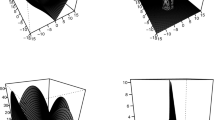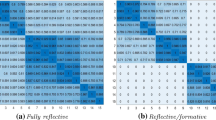Abstract
The common principal components model for several groups of multivariate observations is a useful parsimonious model for the scatter structure which assumes equal principal axes but different variances along those axes for each group. Due to the lack of resistance of the classical maximum likelihood estimators for the parameters of this model, several robust estimators have been proposed in the literature: plug-in estimators and projection-pursuit (PP) type estimators. In this paper, we show that it is possible to improve the low efficiency of the projection-pursuit estimators by applying a reweighting step. More precisely, we consider plug-in estimators obtained by plugging a reweighted estimator of the scatter matrices into the maximum likelihood equations defining the principal axes. The weights considered penalize observations with large values of the influence measures defined by Boente et al. (2002). The new estimators are studied in terms of theoretical properties (influence functions and asymptotic variances) and are compared with other existing estimators in a simulation study.
Similar content being viewed by others
References
Adrover J (1998) Minimax bias-robust estimation of the dispersion matrix of a multivariate distribution. Ann Stat 26:2301–2320
Boente G, Orellana L (2001) A robust approach to common principal components. In: Fernholz L, Morgenthaler S, Stahel W (eds) Statistics in genetics and in the environmental sciences. Birkhauser, Basel, pp 117–147
Boente G, Pires AM, Rodrigues IM (2002) Influence functions and outlier detection under the common principal components model: a robust approach. Biometrika 89:861–875
Boente G, Critchley F, Orellana L (2004) Influence functions for robust estimators under proportional scatter matrices. Available on http://www.ic.fcen.uba.ar/preprints/boecriore.pdf
Boente G, Pires AM, Rodrigues IM (2005) Reweighted estimators for the common principal components model: influence functions and Monte Carlo study. Publicaciones Previas del Instituto de Cálculo. Available on http://www.ic.fcen.uba.ar/preprints/boentepiresrodrigues.pdf
Boente G, Pires AM, Rodrigues IM (2006) General projection-pursuit estimators for the common principal components model: influence functions and Monte Carlo study. J Multivariate Anal 97:124–147
Critchley F (1985) Influence in principal components analysis. Biometrika 72:627–636
Croux C, Haesbroeck G (1999) Influence function and efficiency of the minimum covariance determinant scatter matrix estimator. J Multivariate Anal 71:161–190
Croux C, Haesbroeck G (2000) Principal component analysis based on robust estimators of the covariance or correlation matrix: influence functions and efficiencies. Biometrika 87:603–618
Croux C, Ruiz-Gazen A (2005) High breakdown estimators for principal components: the projection-pursuit approach revisited. J Multivariate Anal 95:206–226
Davies PL (1987) Asymptotic behavior of S−estimates of multivariate location parameters and dispersion matrices. Ann Stat 15:1269–1292
Donoho DL (1982) Breakdown properties of multivariate location estimators, Qualifying paper. Harvard University, Boston
Filzmoser P (2004) A multivariate outlier detection method. In: Aivazian S, Filzmoser P, Kharin Y (eds) Proceedings of the Seventh international conference on computer data analysis and modelling, vol 1. Belarusian State University, Minsk, pp. 18–22
Filzmoser P, Reimann C, Garrett RG (2005) Multivariate outlier detection in exploration geochemistry. Comput Geosci 31:579–587
Flury BK (1984) Common principal components in k groups. J Am Stat Assoc 79:892–898
Flury BK (1988) Common principal components and related multivariate models. Wiley, New York
Huber P (1977) Robust covariances. In: Guta SS, Moore DS (eds) Statistical decision theory and related topics. Academic, New York, pp 165–191
Jaupi L, Saporta G (1993) Using the influence function in robust principal components analysis. In: Morgenthaler S, Ronchetti E, Stahel W (eds) New directions in statistical data analysis and robustness. Birkhauser, Basel, pp 147–156
Kent J, Tyler D (1996) Constrained M-estimation for multivariate location and scatter. Ann Stat 24:1346–1370
Li G, Chen Z (1985) Projection-pursuit approach to robust dispersion matrices and principal components: primary theory and Monte Carlo. J Am Stat Assoc 80:759–766
Lopuhaä HP (1999) Asymptotics of reweighted estimators of multivariate location and scatter. Ann Stat 27:1–28
Maronna R (1976) Robust M-estimates of multivariate location and scatter. Ann Stat 4:51–67
Maronna R, Yohai V (1998) Robust estimation of multivariate locaton and scatter. In: Kotz S, Johnson Nl (eds) Encyclopedia of statistical sciences, update vol 2. Wiley, New York, pp. 589–596
Maronna R, Martin D, Yohai V (2006) Robust statistics: theory and methods. Wiley, New York
Pires AM, Branco J (2002) Partial influence functions. J Multivariate Anal 83:451–468
Pison G, Rousseeuw PJ, Filzmoser P, Croux C (2000) A robust version of principal factor analysis. In: Bethlehem J, van der Heijden P (eds) Compstat: proceedings in computational statistics. Physica-Verlag, Heidelberg, pp 385–390
Pison G, Rousseeuw PJ, Filzmoser P, Croux C (2003) Robust factor analysis. J Multivariate Anal 84:145–172
Rodrigues IM (2003) Métodos Robustos em Análise de Componentes Principais Comuns. Unpublished PhD Thesis (in portuguese), Universidade Técnica de Lisboa. Available on http://www.math.ist.utl.pt/∼apires/phd.html
Rousseeuw PJ (1985) Multivariate estimation with high breakdown point. In: Grossmann W, Pflug G, Vincze I, Wertz W (eds) Mathematical statistics and applications. Reidel, Dordrecht, pp 283–297
Rousseeuw PJ, van Zomeren BC (1990) Unmasking multivariate outliers and leverage points. J Am Stat Assoc 85:633–639
Shi L (1997) Local influence in principal components analysis. Biometrika 84:175–186
Stahel WA (1981) Robuste schätzungen: infinitesimale optimalität und schätzungen von Kovarianzmatrizen, PhD thesis, ETH Zürich
Tyler D (1991) Some issues in the robust estimation of multivariate location and scatter. In: Stahel W, Weisberg S (eds) Directions in Robust statistics and diagnostics Part 2. Springer, Heidelberg, pp. 327–336
Author information
Authors and Affiliations
Corresponding author
Rights and permissions
About this article
Cite this article
Boente, G., Pires, A.M. & Rodrigues, I.M. Estimators for the common principal components model based on reweighting: influence functions and Monte Carlo study. Metrika 67, 189–218 (2008). https://doi.org/10.1007/s00184-007-0129-4
Received:
Published:
Issue Date:
DOI: https://doi.org/10.1007/s00184-007-0129-4




